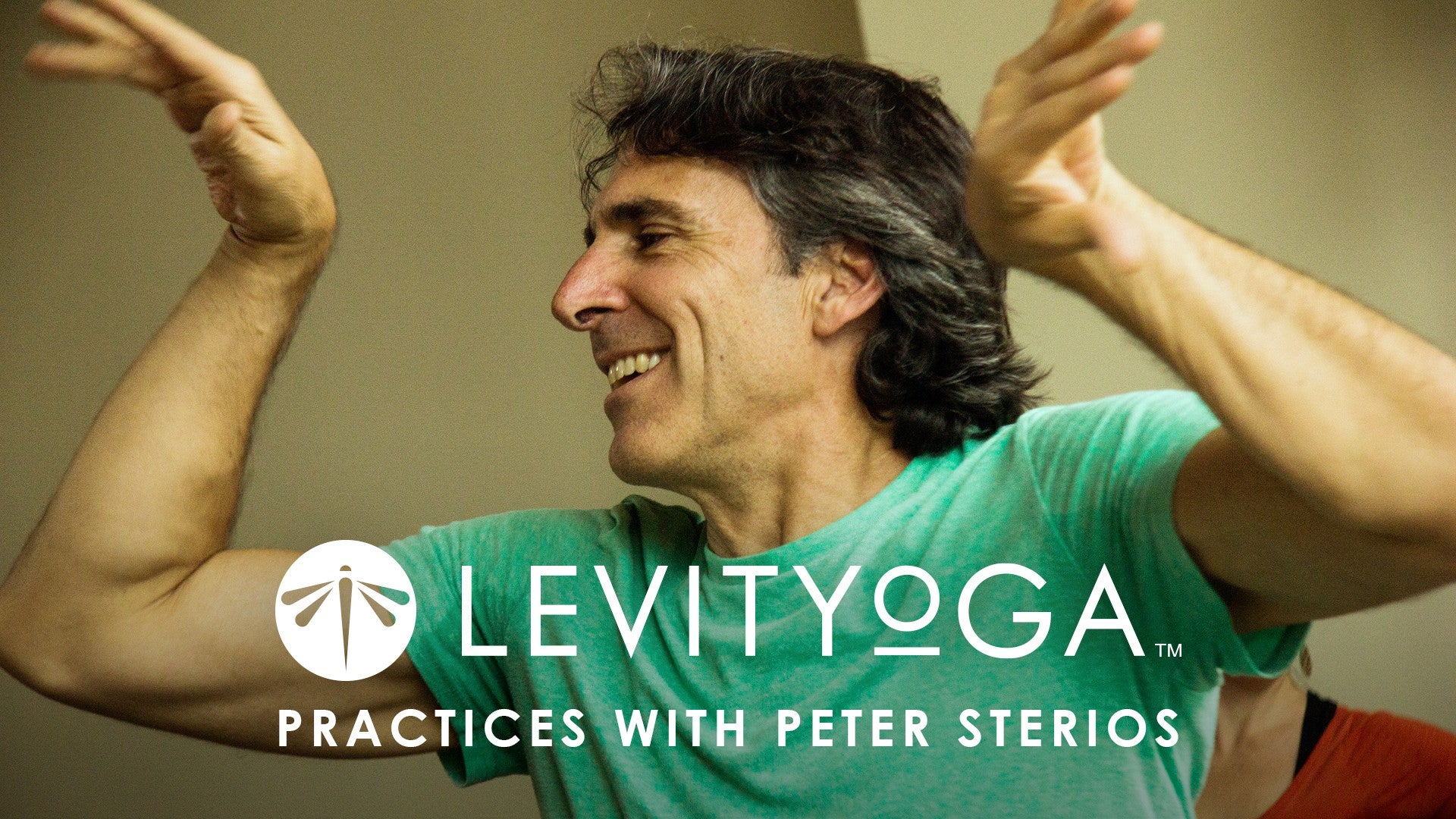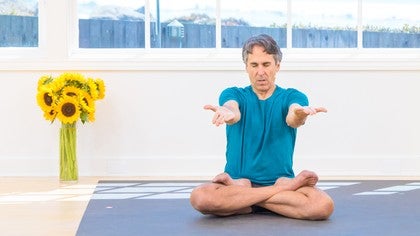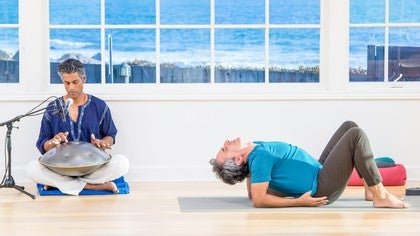Description
About This Video
Transcript
Read Full Transcript
Welcome to the static flow practice. This practice is a little different than practices so far in that it's more of a mental practice than a physical practice and we use the body basically to challenge the stamina of the body and to source power other than muscular effort and it requires a lot of patience and in a way it requires kindness to yourself. By that I mean as the body starts to fatigue try to keep the mind from reacting to that fatigue in habitual ways. That fatigue is because the muscles are being taxed but the mental, the willpower let's say is you're working to keep that intact. We will use very simple safe poses with extended holds and the work also involves a bit of creativity in terms of adapting. As the body fatigues you definitely have a certain physical limit and I'm encouraging you to either adapt the pose like for instance if I'm asking you to hold your arms out and the arms are fatiguing you can lower the hands until you can support. Try not to rest but keep them just above the floor. If you do need to rest though go ahead and rest but then rejoin us. Try to take what you need to recover from the fatigue and then when you feel stronger bring the hands up if you're using this pose as an example. Alright so if we start in child's pose it's to allow this rhythm to your breath that you want to try and maintain through the whole practice. So let's come up onto your hands and knees. With your knees together sit back on your heels and fold forward into child's pose. Release your arms fully. In child's pose begin by slowing your breath down and finding a rhythm that you feel you can maintain throughout the whole practice. I suggest starting with a three to four second inhale, three to four second exhale. With each inhale following the fullness of your breath into the back the full length of your torso. On the exhale soften the hip crease, belly and ribs. Feel gravity pressing you down onto your thighs. Keep the sound of your breath soft, the texture of your breath smooth. One more, slow inhale, slow exhale. And inhale sit up and come up into a simple cross-legged position. If you're comfortable in lotus you can sit in lotus, otherwise just simple cross-leg.
Place your hands flat on the floor in front of you and with straight arms head in line with your neck breathe into the back body. On the exhale release through the shoulders, chest and belly. Inch the fingers forward. Extend the spine from the back of the skull. Each inhale coming out of the pose slightly. Each exhale release through the shoulders, chest and belly. Inch the fingers forward. So this preparatory pose cross-legged is just to warm up your hips a little bit. One more breath, inhale, exhale, release through the shoulders, collarbones drop, inch the fingers forward. And inhale sit up, change the crossing of your legs and other side. Palms flat, arms straight, head in line with your neck. Three to four second inhale, so you're maintaining that rhythm from Child's Pose. Exhale, release through the shoulders, soften through the diaphragm, organs drop, extend the spine. Each inhale let the fullness of your breath lift you out of the pose slightly. Each exhale, re-release the collarbones, armpits drop, release the diaphragm, abdominal organs drop, inch the fingers forward. One more. Now inhale sitting up, take your arm shoulder height, head upright, release your collarbones, extend out through the fingertips. Breathe into the front side and back of the lungs, the full length of your torso. Each exhale, re-release your collarbones, extend out through the fingers. Try to keep your wrists soft and then the thumbs soft, keep your fingers active. Each exhale as you release the diaphragm, gently press the top of the hip bones forward without leaning forward.
Draw the chin slightly in toward your throat, lift the spine from the back of the skull. Notice as the arms begin to fatigue, try to keep the extension in the fingers, keep the shoulders passive, armpits sinking. If it's easier for you to close your eyes, close your eyes, keep your attention with your breath. Each exhale, release through the front body, lift through the back of the skull, extend out through the fingers. Keep the legs passive, top of the hip bones gently pressing forward. As the shoulders start to compensate for the fatigue, they tend to grip. With each exhalation cycle, re-release your collarbones, extend out through the fingers, and now slowly turn your palms to face up. Check your hands, make sure they're flat. Each exhale, diaphragm releases, abdominal organs drop, tailbone drops, keep the top of the hip bones gently pressing forward. Each exhale, re-release the collarbones, extend out through the fingers. See if you can see the difference with the cycles of breath and the inhale, there's this expansive quality, almost like a pause, like a break in the pose. Each exhale, there's a softening and a warming, and you feel more energy to go into the pose deeper. That inhaling breath is a physical and psychological break. Exhale, releasing unnecessary tension in the body, creating more length and space, more softness, and slowly pull the fingers down, flex the heel of the palms. Notice if you tense in the diaphragm as the fingers come down, re-release your diaphragm, keep the spine engaged from the back of the skull.
Pull the fingers down more, re-release your collarbones. Mentally scanning the body for any places of unnecessary tension. Check your jaws, check your tongue, re-release your collarbones, these are the obvious ones. Checking in the pelvic floor, release the sphincter muscles, and slowly spin the fingers up, pressing out through the palms, pull the tips of the fingers back towards your ears, pull the arms back about a foot on each side, spreading the skin across your chest. Rest if you need to. If you are resting, don't stay too long, just rest enough till you regain your energy and your willpower, and then bring the arms up to whatever level you can maintain. Keep the rhythm of your breath slow. Notice if the mind is going into a story, try to move the mind back to the present, following the sensation of your breath from the tip of the nostrils through the back body into the pelvic floor. Each exhale, re-release through the collarbones, press out through the palms, pull the fingers in. Now slowly curl the wrists down, curl the fingers, try to touch the underside of the forearms, slowly swing the arms forward till they're parallel, release your collarbones, press the wrists forward, close your eyes. So if you mentally observe the shape of this pose, you'll find that you're moving your energy in a way that this external form has a kind of zombie appearance. Mentally you're present, physically you're a zombie. Release your collarbones, press the wrists forward, breathe into the back of the heart, spread the skin across your shoulder blades. On the exhale, top of the lungs softens, heart drops, pull the chin in towards your throat, lift the spine from the back of the skull. If the body starts to shake a little bit, that's okay. Just allow the shaking, but don't lose the engagement in the arms. Keep the shoulders passive, keep the belly and diaphragm soft, feel the weight of your abdominal organs resting heavy in the pelvic floor. And slowly extend the fingers forward, turn the palms up, bend in the arms, touch your shoulders, lift your elbows. Don't get drunk on how good that feels. Walk the fingertips down the spine a little further, try to press the forearms together behind your head. Relax your diaphragm, feel the organs drop, tailbone drops, keep the top of the hip bones forward. Each exhale, releasing the collarbones, try to press your elbows a little closer. Walk the fingers a little lower. And right hand grabs the left elbow, pull the left arm behind your head, drop the right arm behind your back. And just notice if the hook is a little easier right now. This is just a resting pose and just a check-in. Quickly release, change arms, left hand grabs the right elbow, pull the right arm behind the head, left arm behind the back, hook the fingers, and release. Hands return to the shoulders, squeeze the elbows, walk the fingertips a little lower, and pull the elbows out to the side and as far back as you can. Clench your fist, pump your biceps. We won't hold this long. Each exhale, chest dropping, diaphragm soft, organs dropping. Clench the fist tighter. And now interlock the fingers, press the palms up. And again, this feeling of release. Try not to get your tension to drift. Keep your attention with the breath. Release your diaphragm, press the hands higher. Soften the top of the lungs, soften the collarbones. Breathing here into the front side and back of the lungs, the full length of your torso. Each exhale, release through the front body, press up through the hands, lift through the back of the skull. Three to four second inhale, three to four second exhale. Following the sensation of your breath from the tip of the nostrils, up through the nasal passages, down the back of the throat, back of the heart, back of the belly, into the pelvic floor. Each exhale, diaphragm releases, abdominal organs drop, top of the lungs softens, heart drops, collarbones soften, shoulders drop.
Press your hands higher, lift the spine from the back of the skull, chin in slightly towards your throat. One more minute. Try not to fidget, try to keep that deep quality of stillness in the external body. The internal body active, alert, recognizing where you're subconsciously holding tension in the chest, in the shoulders, in the belly. Releasing that unnecessary tension, engage the arms higher, lift the spine higher. Release the sphincter muscles, tailbone drops. Feel the ground beneath you. Keep the gaze of your eyes soft, sides of the tongue soft, throat soft. And now just the last 30 seconds. Take the hands back, arch in the upper back. When you reach your maximum, pause there. And with each exhale, top of the lungs softens, heart drops. See if you can move your hands just a little further back. Keep the gaze of your eyes soft. 15 seconds. Releasing the hands to the shoulders, press your elbows together in front of your nose and squeeze the elbows strongly. Feel the latissimus muscles on the side of the torso engage. Feel the pectoralis muscles in the chest engage. Squeeze your elbows. Keep the rhythm of your breath slow, the sound of your breath soft and smooth. The last 30 seconds. Squeeze the elbows more, keep the elbows up if you can, shoulder height. Relax your diaphragm, organs drop. Lift the spine from the back of the skull. Now, sliding the fingers under your shirt, curl the tips into the trapezius, hooking the flesh, pull the elbows down, raking the trapezius forward. Lean your head back, chin sinking toward your throat, neck supported in the trapezius. And slowly extend your chin up. Then bring the head upright, bring your elbows up. Exhale the hands forward, palms up. Inhale the arms apart. Exhale, right arm over the left, palm down, arms cross and hold. Lean forward a little, pull the navel back. Lift the spine from the back of the skull. Try to keep the arms separated, don't rest the upper arm on the lower arm. Release your collarbones, extend out through the fingers. Keep the rhythm of your breath slow. If the mind drifts into stories, try to move your attention back into the breath. Stay present with the breath. As the muscles fatigue, release your collarbones, extend out through the fingers. If you're shaking a little, that's okay. Keep moving your attention back to your breath. Keep releasing any unnecessary tension. If the torso is leaning back a little, lean forward a little, pull the navel back a little. Keep the arms up. 30 more seconds here. Keep the gaze soft, sides of the tongue soft, throat soft. With an inhale, take the arms apart. Other side, last one.
Release your collarbones, extend out through the fingers. Keep the arms separated. Keep the spine engaged lightly from the back of the skull, chin in. If you're leaning back, lean your torso forward a little, pull the navel back a little. Feel the weight of your abdominal organs heavy in the pelvic floor, spine light and lifting from the back of the skull. Cross the arms a little further. 30 seconds. Scanning for any unnecessary tension in the physical body. Finding any drifting away from the breath mentally. Keep returning your attention to the breath, not the fatigue in your shoulders or arms. Feel the quality of the inhale giving you a little break. The quality of the exhale creating space and a little more movement. With an inhale, take the arms apart. Turn the palms back, facing each other. Lift your hands as high as you can. Lift your chest, head upright. Each exhale, release through the shoulders and chest. Lift the hands higher. Pull the chin in towards your throat, lifting the spine gently from the back of the skull. If you're leaning back, lean forward a little, pull the navel back. Take the hands higher. Feel the triceps engage. Deltoids passive. 30 seconds. The last 15 seconds, turn the palms to face up, lift your hands higher. Try not to fidget. Keep the body, the physical body, the shell, let's say, as still as possible. The inner body dynamic. Feel the flow of the inner body. Feel the mind present, out of story. And now releasing the hands forward, close your eyes. Shoulders passive, arms heavy. Gently draw the hands in until they almost touch. Almost touch, say half inch apart. And then visualize something soft like a slab of jello in your hands. And just gently squeeze that jello with your hands without them touching. Keep your shoulders passive, arms heavy. Feel how that image, that visualization of jello pushes back into this hands, into the skin.
All right, slowly release. Come up onto your hands and knees. Tuck your toes forward and sit on your heels. Hands resting on the thighs. Slow your breath down. Pull your heels in a little closer. If it helps, close your eyes. Keep your attention with your breath. Each exhale, top of the lungs, softens, heart drops. Feel the joy in your arms and shoulders. That may help you take the mind off the less joyful feeling in your toes. Each exhale, try to soften the skin between the ball the foot and the big toes. As you release that space between the ball and the toe, the toe energetically lengthens a little. You get a little more space, a little less pressure into the toe joint. Keep your belly soft. You're the weight of your abdominal organs, heavy in the pelvic floor. Breathing into the front side and back of the lungs. Releasing any unnecessary tension in the body. Releasing the sphincter muscles. Releasing the skin below your navel. Releasing the diaphragm. Releasing the top of the lungs, the collarbones, the throat. One more minute. Three to four second inhale, three to four second exhale. Keep returning your attention. If the discomfort in the feet is too intense, try and move your attention back into the joy in your shoulders and arms. And now bring your hands to the floor. Lift your knees up into a squat. Let your heels descend. Walk the hands forward. We'll take a little break here. Arms straight. Squeeze your knees in a little. Soften your ankles. Feel your heels descend. Those of you that are flexible with the heels flat already, you can walk the hands forward a little so the heels hover just above the floor, consciously softening the ankle. Alright, the counter pose for the toes. Roll onto the face of your toenails. If this is too intense, do one foot. Stay as long as you can, then do the other foot.
If you're on both, head upright. Slow your breath down. We won't stay here long. And now dropping down onto your knees. Lean back. Lift the knees. Then hands forward. Roll back over the toes. Plank pose. Hands shoulder-width apart. Hips in line with your shoulders and heels. Head in line with your neck. Slow your breath down. Each exhale. Pull the navel up a little. Tailbone down a little. Engage your legs. Three to four second inhale. Three to four second exhale. One more minute.
The last 30 seconds, bend your knees one inch off the floor so your thighs are almost vertical. Keep your breathing slow. Pull the navel up a little. Tailbone down a little. From bent leg plank, push back into squatting dog. Keep your knees one inch off the floor. Press back. Lower the head. Release your collar bones. Engage your arms. And now full dog. Slowly straighten your legs. Re-adjust your hands if you need to. Release your head and shoulders. So we'll start here in this kind of bronze metal dog. Not your best ever dog. Each inhale let the fullness of the breath lift you out of the pose. You can keep your knees a little bent. Each exhale soften through the hips and shoulders. They sink a little. Releasing the sphincter and the skin below the navel. Feel the waist release. Release your head. Soft, smooth, slow breath.
Each exhale. Hips and shoulders soften. Arms and legs lengthen. Re-adjust your hands as needed. Try to feel the texture of your mat with your hands and feet. The quality of the touch is soft without losing the tone in the arms and legs. Hips and shoulders passive. Releasing the back of the skull, the sphincter muscles, and the skin below your navel. Try to keep the weight even on your hands front to back, side to side. Each inhale letting the breath lift you out of the pose slightly. And feel that psychological and physical release or break from the pose. Like you're coming out slightly. Each exhale, re-release the hips and shoulders. Re-engage the arms and legs. Releasing the back of the skull, sphincter muscles, and the skin below your navel. Make sure you're not overextending the fingers. Not spreading them too wide. The fingers should be about one finger width apart from its neighbor. So you feel this touch, almost like you're about to touch a child or a lover in the hands, even in the feet. Mentally scanning the body for any unnecessary tension in the pelvic floor, in the belly, in the shoulders, in the chest. Keep the arms and legs engaged. If you need to rest here, drop down onto your knees. Keep your arms engaged. One more minute. On an inhale, coming out, coming into plank, head down. Keep your head down and then rolling over the toes. Lift your head up, shoulders forward, chest dropping, hips dropping, thighs lifting, upward dog. Keep your head upright. Don't take the head back yet. So each inhale, breathing through the back body, feel the hips lift a little away from the floor. On the exhale, release through the sphincter muscles, the skin below your navel, hips drop, lift your thighs, press down into your hands, lift up through the back of the skull, shoulders slightly forward.
Feel the energy of your chest dropping towards your navel, spine lifting through the back of the skull. Keep your face soft, the gaze of your eyes soft, tongue soft. 30 more seconds. Last 15 seconds. If your lower back is strong, chin in, head back, gaze up, neck resting in the trapezius, shoulders forward, chest dropping. Alright, coming back into plank, roll over the toes, step forward with your right foot, spin to your left, pull the heels in, bend your knees, raising the torso upright, hands namaste at your heart, elbows up, squeeze your palms together, pull the navel in, tailbone down, head upright. Keep the weight even on your feet front to back, side to side, breathing into the front side and back of the lungs. Each exhale as you soften through the front body, hips sink a little, take the knees back a little, lift the spine gently from the back of the skull, squeezing the palms gently, elbows up, release your collar bones, armpits drop, feeling the texture of your mat with your feet. Mentally scanning any areas of unnecessary tension, especially around the diaphragm, around the pelvic floor, around the shoulders. Keep the spine engaged lightly from the back of your skull.
One more minute, sink a little lower, pull the navel in, tailbone down, if your thighs burn a little, keep your attention with your breath. Last 30 seconds, keep your legs as they are, hands to the floor, lift your heels up, knees wider, hips lower, keep your breathing slow. And now straight legs, heels wide, toes turned in, straight arms gaze forward. Yes, that's the delightful feeling. Exhale, fold forward, grab the backs of your heels, release your head and shoulders. Don't be aggressive with your arms here, keep the weight even on your feet, side to side, front to back, and release the back of your skull. Each inhale, let the fullness of the breath lift you out of the pose slightly, spreading the skin across your buttocks. On the exhale, release the sphincter and the skin below the navel. Feel your abdominal organs recede a little towards the spine, waist lengthens a little, lean your hips forward without the toes gripping, re-release your head and shoulders. Three to four second inhale, three to four second exhale. Enjoy the straight legs as you transition from horse, as the straight legs start to fatigue, try to remember that almost prayer that you had when you were in horse for straight legs. Here you have your straight legs, see if you can be happy with the prayer that was answered. Work by releasing through the pelvic floor, releasing that energy in the chest and shoulders so you feel your torso hanging from the hips. Don't be aggressive with your arms, keep your toes passive, feeling the texture of your mat with your feet. One more minute. Last 30 seconds, take the arms behind the back, interlock your fingers, palms apart, slowly drape the arms over the head. Keep the weight even on your feet, release your shoulders, let the hands drop, don't push. If you're shaking just keep your attention with your breath, release your head and shoulders.
Releasing the hands, spin to your left, step back, drop down onto your knees, knees together, feet apart and sit between your heels. If this is too much for the knees you can bring your heels in a little, just resting the outer hip onto the inner heel. Rest your hands on the knees, release your collarbones, head upright, close your eyes, shoulders passive, arms heavy, legs passive, hips heavy. Slow, smooth, even breathing. As you relax the diaphragm, feel the weight of the abdominal organs drop, tailbone drops a little, draw the chin in towards your throat, lift the spine gently from the back of the skull, shoulders passive, arms heavy. Turn the gaze of your eyes down as if you're looking through your cheeks and consciously soften the optic muscles behind your eyes. Feel the weight of the eyeball drop deep into the sockets, as if your eyeballs were resting on your upper jawbones. And curl the tip of the tongue and place where the upper gum and palate meet, place the tip of the tongue. Soften the sides of the tongue, feel the root of the tongue sinking. And now slowly curl the tip of the tongue along the palate towards the back of the throat. Go slow, don't be aggressive with the tongue. When you reach that maximum curl back towards the throat, pause there. Soften the sides of the tongue if you can without the tongue retracting. Then consciously contract the soft palate near the back of the throat forward to meet the tip of the tongue and see if that helps you slide your tongue back even further, as if you could swallow your tongue. Keep the gaze of the eyes turned down. And releasing the tongue let it float, release your gaze let it float. Take your hands to the floor. Take the knees apart, sitting on your heels, going forward into child's pose, arms forward. Rest your forehead on the floor. Relax your arms.
Slow your breath down. Each inhale, following the fullness of your breath through the back, feel the skin of the back spreading the full length of your torso. Each exhale, soften through the front body. Slide your nose forward as the spine lengthens, inch your fingers forward if you need to. Be as passive as you can be. Take weight on your nose and forehead. Try to soften the hard cartilage of your nose into the mat. Soften the frontal lobe of the brain. And when you're ready, slowly sit up. This completes the static flow practice. Namaste.
LEVITYoga: Develop Curiosity
Comments
You need to be a subscriber to post a comment.
Please Log In or Create an Account to start your free trial.













